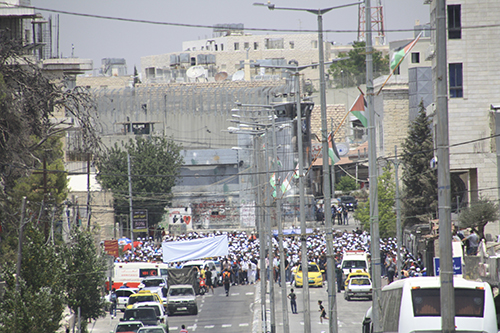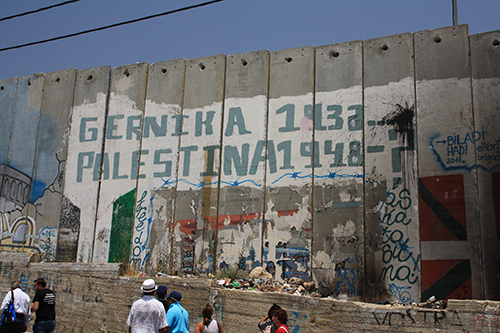
During a trip to Jerusalem in 2017, John Nixon , a retired Peoria physician, photographed protesters near a refugee camp near Bethlehem. This was part of regular Friday protests following restricted access to the Temple Mount, a site revered by both Jews and Palestinians. (PHOTO BY JOHN NIXON)
Retired Peoria pathologist John Nixon studies widespread human rights violations in Gaza with increasing alarm. As a physician, he felt he should not speak out while he was treating patients, but after retiring 12 years ago, he has studied the issue more intently, traveled and become more vocal.
“Gazans are screaming for our help,” he said recently. “We’ve got to call out our own country on this.”
He calls Gaza “a human warehouse and ethnic prison.”
Nixon said his parents were always concerned with civil and human rights. His father was a political science professor and his mother grew up in South Africa.
“My focus on this issue isn’t Israel itself but its policies,” he said. “If you take the position that Israel is a Jewish state for a Jewish population that is like saying the United States is a white Christian country only. That would be like saying the Freedom Riders in the South were anti-American.”
Holding a different perspective is Susan Katz, executive director of the Jewish Federation of Peoria.
Katz said Palestinians who are confined to Gaza have elected Hamas, an internationally-recognized terrorist organization that has pledged to destroy the nation of Israel and organizes regular military incursions against Israeli citizens.
“What is Israel to do in the face of Hamas aggression?” she asked.
Under the growing weight of news accounts, increasing death tolls, facts, figures and narratives from both perspectives, Rabbi Brant Rosen was invited to Peoria to speak recently by the interfaith team of the Presbytery of Great Rivers.
Rosen is an advocate for Gazans’ human rights.
“How could Brant Rosen talk about Gaza and not mention Hamas? That’s disingenuous,” Katz said. “Living conditions in Gaza are horrendous, but he did not mention that humanitarian aid is sent daily into Gaza from Israel.”
Acknowledging that Gazans are under siege, she said Israelis also live under growing threat. She said Israel never targets civilian populations, but Hamas regularly does. She said the Israeli military always gives advance notice to civilians of a strike.
In citing one missile attack, Nixon said, “Advance notice of 8 seconds was given. How do you get someone in a wheelchair out in 8 seconds?”
Community Word was the only local media at Rosen’s talk in Peoria. Following publication of our piece, Katz contacted Community Word to say she was “disturbed and disappointed” with our coverage that was published in the May issue.
“I don’t feel Brant Rosen’s talk was productive or helpful. He put 100 percent of the blame on Israel,” she said, contending Rosen’s views are so skewed that he has virtually no support among the American Jewish population, even among extremely liberal Jewish communities.
“The people in Gaza are under siege, but there was no acknowledgment that the people in the south” of Israel are also under siege and living in fear, she said, noting that children and adults in Israel suffer post-traumatic stress disorder.
Nixon offered statistics from the conflict during a recent 12-month period:
- 304 Gaza Palestinians killed; 6 Israelis killed
- 31,691 Gaza Palestinians injured; 250 Israeli injured
Katz said a two-state solution is one resolution, but during the recent elections in Israel, the two-state solution was infrequently mentioned, overshadowed by a focus on security. Following Rosen’s talk in Peoria, Katz noted that he was asked if he supports a two-state solution, but he did not reply.
Nixon said some visions of the two-state solution are based on small, contained pockets of Arab Palestinian populations surrounded by land controlled by Israel. When people talk of a two-state solution, the borders and land must be equitable in order to be meaningful.
Nixon said, “I support a solution with equal rights for all and modern standards of human rights applied to all without dominance by one ethnic group over another. Israel wants to maintain racial supremacy. That is like the Bantustans in South Africa –– little geographic areas for the indigenous population.”
It’s a form of isolation and containment, he said.
Nixon and his wife traveled to Palestine in 2017 to study the situation first hand. He saw blatant inequality among Jews and Arabs and said the policies amount to “ethnic cleansing of Palestine.”
“The problem is that if you feel Palestinians deserve equal human rights, does that make you anti-Semitic? Support for policies that are profoundly, overtly discriminatory gives justification for white nationalists. Promoting Islamophobia also promotes anti-Semitism,” Nixon said. “Support for equal human rights in Israel and Palestine does not promote anti-Semitism. It combats anti-Semitism.”
“The biggest existential threat (to Israeli policies) is open discourse in the United States,” Nixon said, contending it is easy to look to the past and call out human rights violations. It’s harder to call out these violations in our time, but if we don’t call them out, we are complicit.
The creation of Israel in 1948 after World War II was to form a safe haven for Jews fleeing centuries of persecution. Palestinians were forced from their ancestral land. Family farms were confiscated. Palestinians continue to protest the seizure of their land.
Today, criticism of Israeli policies is often conflated with anti-Semitism. The BDS Movement (Boycott, Divestment and Sanctions), designed to pressure Israel over policy issues, is widely condemned as anti-Semitic. In one case, an American Muslim teacher in Texas lost her job because she refused to sign a “No Boycott of Israel” clause. The courts ruled in favor of the teacher’s First Amendment rights.
A number of college teachers have been denied tenure for their support of BDS. Two young Muslim members of Congress, Rep. Ilhan Omar, D-Minn., and Rep. Rashida Tlaib, D-Mich., are under constant attack for their support of BDS.
Some people supporting Israel believe the end game of BDS is to create an influx of Arabs into Israel who will then have equal voting rights and will vote to end Israel.
Several weeks ago, Germany passed a resolution denouncing BDS as anti-Semitic and called on other countries to follow. The resolution stated that Germany supports a two-state solution leading to a “Jewish, democratic State of Israel and an independent, democratic and viable Palestinian state.”
Nixon said the Israel lobby is equal in power to the National Rifle Association in the United States. He said arguments that Israel has a right to defend itself do not square with the reality on the ground.
“This is a linguistic rabbit hole,” he said.
Israel may have a sophisticated military and Gazans may not, but Hamas uses civilian shields to protect its soldiers, Katz said. When news accounts document that Israeli attacks killed a family at home or children in a school, that’s because Hamas was using those locations to launch its attacks, she said, noting that Israel is defending itself against a terrorist organization that uses civilian human shields and has pledged to obliterate the Jewish state.
The American news media has been universally blasted for its coverage of the Arab-Israeli conflict. Brant Rosen said The New York Times blatantly favors Israel. Katz believes The New York Times is blatantly unfair in its criticism of Israel.
One recent Times headline read “Gaza militants fire rockets. Israel responds with airstrikes.”
The article stated 150 rockets were fired from Gaza into southern Israel and the Israel military responded with airstrikes against targets in Gaza.
Katz cited reporting indicating it was actually 700 to 750 rockets fired from Gaza toward Israel.
Nixon said other reporting indicated rockets from Gaza were fired in retaliation for Israeli attacks.
Both Katz and Nixon want people to critically analyze the news and not buy into the talking points.
The Gaza Strip is about 3 to 7 miles wide and 25 miles long. About 2 million people are confined on that narrow strip of land with minimal medical care, inadequate food, housing and water.
“That’s like 2 million people being confined in the space between Peoria and Lacon,” Nixon said.
Gaza has been called the most densely populated region in the world. The UN issued a report in 2017 indicating that because of these conditions, Gaza could be uninhabitable by 2020.
Nixon said much of western media accounts must be cleared by Israeli censors. For independent internet sources, he recommends: Mondoweiss, Informed Comment by Juan Cole and The Electronic Intifada.
For objective, balanced reporting, Katz recommends: The Atlantic, National Post (Canadian newspaper with expansive international coverage), Newsweek, Foreign Policy news, Times of Israel and Yossi Klein Halevi.
Asked to state his overarching goal, Nixon said, “I’d like to see modern standards of civil and human rights apply.
“How to get there? The solution is probably within the United States. Israel remains dependent on the United States, so to a large extent it is the responsibility of the United States. More people have to realize what is really happening and support equal Palestinian rights. Heightened awareness is needed, but I question if it will come fast enough to prevent a complete ethnic cleansing.”
Nixon said human rights are intersectional. The basic human rights of Palestinians, Jews, Blacks, women and all other groups are connected. They all have to be respected.

John Nixon photographed this wall mural at a refugee camp near Bethlehem during a trip in 2017. The graffiti reiterates the theme of Picasso’s “Guernica,” painted by the artist in 1937. Picasso’s work is considered one of the most powerful political works of art showing the devastation of war and the suffering of civilians. Picasso painted “Guernica” to protest German bombing of the Basque town of Guernica. This wall mural draws a comparison with the division of Jerusalem in 1948 into separate regions for Jews and Palestinians. (PHOTO BY JOHN NIXON)
